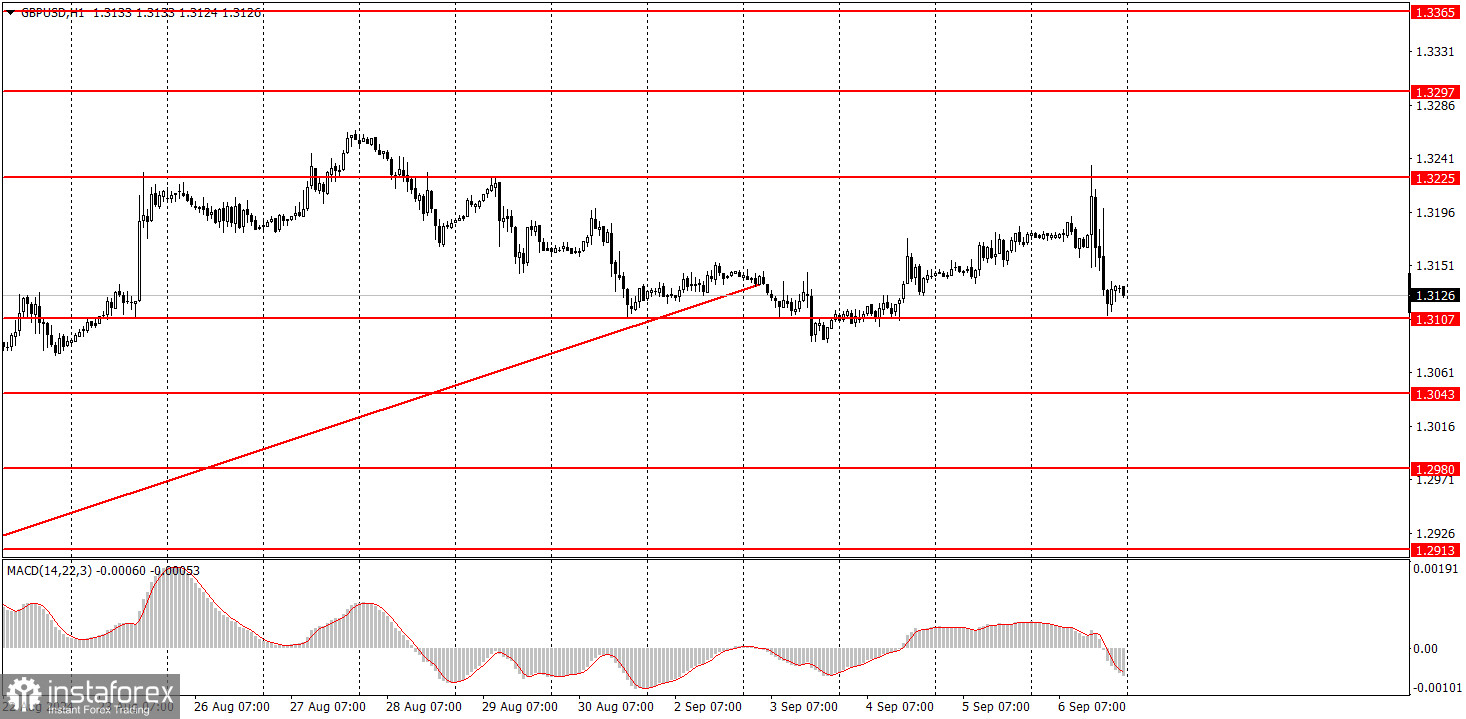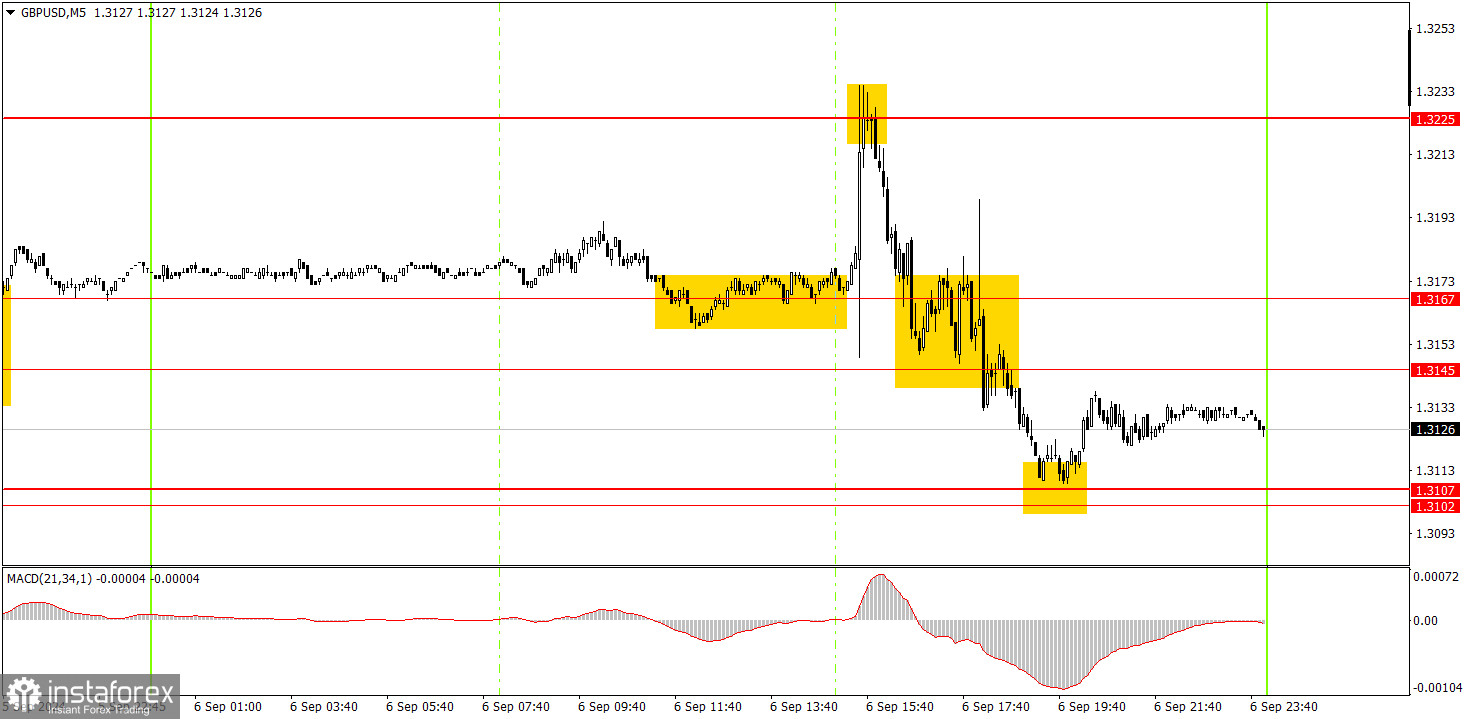Analyzing Friday's Trades:
GBP/USD on 1H Chart

The GBP/USD pair also showed a downward movement on Friday. The dollar rose based on the U.S. labor market and unemployment data, which seemed miraculous. However, the reports themselves were again not the best. The unemployment rate decreased in August, precisely what the market had anticipated. The NonFarm Payrolls number was slightly below forecasts, and July's figure was revised downward. Therefore, it's hard to call this data "positive." Let's say it was better than it could have been. The dollar rose by 50 pips, which under current circumstances means absolutely nothing. Sales of the U.S. currency could easily resume next week as the overall U.S. labor market continues to face issues, and the market expects the Federal Reserve to begin addressing these problems in September by lowering the key rate according to the most aggressive scenario.
GBP/USD on 5M Chart

In the 5-minute time frame on Friday, it traded quite well from a technical point of view. The first trading signal was formed even before the release of important data in the U.S., near the level of 1.3167. But it was hardly worth working out since entering the market five minutes before the release of Nonfarms is not the best idea. But after half an hour, a very good sell signal was formed near the level of 1.3225. Subsequently, the price got stuck for a short time in the area of 1.3145-1.3167, after which it dropped to the area of 1.3102-1.3107, near which the downward movement ended. Thus, novice traders could open one short position, which brought a profit of about 90 pips.
How to Trade on Monday:
In the hourly time frame, GBP/USD has a good chance of resuming the global downward trend or at least experiencing some decline. The British pound remains overbought, the dollar is undervalued, and the market continues to use every opportunity to buy the British currency and sell the dollar. The pound only shows a minor bearish correction and is inclined to rise. It is too early to speak of a full-fledged downtrend.
The pair could move in any direction on Monday, but we will likely see a flat market. There have been no new reasons for the dollar to rise this week, although the dollar remains overly sold.
The key levels to consider on the 5M timeframe are 1.2605-1.2633, 1.2684-1.2693, 1.2748, 1.2791-1.2798, 1.2848-1.2860, 1.2913, 1.2980-1.2993, 1.3043, 1.3102-1.3107, 1.3145-1.3167, 1.3225, 1.3272, 1.3310. On Monday, no significant events are scheduled in the UK or the U.S., so the market will have nothing to react to.
Basic Rules of the Trading System:
1) The strength of a signal is determined by the time it takes for the signal to form (bounce or level breakthrough). The less time it took, the stronger the signal.
2) If two or more trades were opened around any level due to false signals, subsequent signals from that level should be ignored.
3) In a flat market, any currency pair can form multiple false signals or none at all. In any case, it's better to stop trading at the first signs of a flat market.
4) Trades should be opened between the start of the European session and midway through the U.S. session. After this period, all trades must be closed manually.
5) In the hourly time frame, trades based on MACD signals are only advisable amidst good volatility and a trend confirmed by a trendline or trend channel.
6) If two levels are too close to each other (5 to 20 pips), they should be considered a support or resistance area.
7) After moving 20 pips in the intended direction, the Stop Loss should be set to break even.
What's on the Charts:
Support and Resistance price levels: targets for opening long or short positions. You can place Take Profit levels around them.
Red lines: channels or trend lines that depict the current trend and indicate the preferred trading direction.
The MACD indicator (14,22,3): encompassing both the histogram and signal line, acts as an auxiliary tool and can also be used as a source of signals.
Important speeches and reports (always noted in the news calendar) can profoundly influence the movement of a currency pair. Hence, trading during their release calls for heightened caution. It may be reasonable to exit the market to avoid sharp price reversals against the prevailing movement.
For beginners, it's important to remember that not every trade will yield profit. Developing a clear strategy and effective money management is key to success in trading over the long term.
 English
English 
 Русский
Русский Bahasa Indonesia
Bahasa Indonesia Bahasa Malay
Bahasa Malay ไทย
ไทย Español
Español Deutsch
Deutsch Български
Български Français
Français Tiếng Việt
Tiếng Việt 中文
中文 বাংলা
বাংলা हिन्दी
हिन्दी Čeština
Čeština Українська
Українська Română
Română

